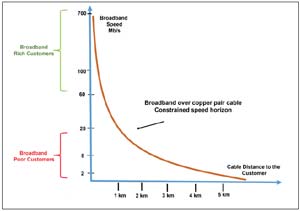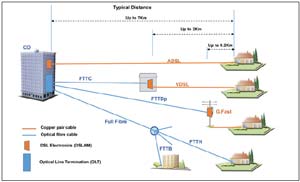
A Digital Economy Thrives on Fibre Rich Broadband Networks However not all countries are proceeding at the same pace
John Marshall, Chief Technology Officer, ECI Telecom

 John Marshall, Chief Technology Officer, ECI Telecom
John Marshall, Chief Technology Officer, ECI TelecomBroadband speeds continue to be a universal topic of discussion these days particularly in view of the ever-growing pace of new broadband hungry applications such as ever-higher quality video, gaming, cloud/data storage services not to mention Artificial Intelligence and Robotics coming over the horizon. Speeds are not the only issue however; higher levels of reliability and operational performance are also needed as more customers rely on the internet for mission critical and often lifeline services.
Whilst broadband service is now universally available across Europe, there remains significant variation in speeds and performance available to customers and many continue to suffer insufficient speeds to meet their basic needs, often well below 10 Mb/s. Cries from children whose gaming activity is impaired when dad uploads important business files are still not uncommon. The cause of such low speeds usually resides in the broadband connections routed over metallic (usually copper) cables of the national telephone network, which was the network of choice for broadband delivery when the internet and web first emerged back in the early 1990s. Such cables however progressively attenuate broadband data as frequency (speed) and distance increases and this combined with electrical noise (both external and crosstalk between cables) imposes an almost inverse relationship between the broadband data speeds that a customer can reliably receive and their metallic path distance to the Central Office (CO) or Broadband data source as illustrated below
Since customers can reside anywhere between a few hundred metres and up to 7 Km from their Central Office (CO), an unsatisfactory ‘Digital Divide’ is inevitably created between the so called ‘broadband rich’ and ‘broadband poor’ within the Telco’s network footprint.
Total fibre connections, usually referred to as Full Fibre, Fibre to the Home (FTTH) or Fibre to the Building (FTTB), and are now being rolled out across Europe
The solution lies in removing the copper cables completely and replacing them with optical fibre which has none of the impairments described above. Being very low loss and immune to electrical noise and interference, it enables almost unlimited customer broadband speeds (Gb/s +) to be delivered uniformly across the customer footprint. Modern optical fibre cable infrastructures are also intrinsically more robust and reliable compared to the existing often-aging copper cable infrastructure with its questionable joints and terminations.
Total fibre connections, usually referred to as Full Fibre, Fibre to the Home (FTTH) or Fibre to the Building (FTTB), are now being rolled out across Europe. However, there does appear to be a noticeable difference between countries as to the pace of their deployment with some countries achieving almost 50% of the customer base connected and others below 10% as presented in this year’s FTTH Europe conference and illustrated below.

The reasons for the disparity between countries are multi-faceted but hinge primarily around the differences in fiscal and regulatory environments governing Telco investment plans including levels of government subsidy as well as partnership arrangements with broadband stakeholders. Demographics also have some influence in terms of proportion of apartment blocks versus residential properties, as the latter are more expensive to fibre.
Countries less able to substantially replace their copper cable infrastructure have nevertheless made significant inroads by replacing major sections of it with optical fibre and so reduce the metallic path distances with corresponding improvements in average customer broadband speeds.
The general stages of such replacement are illustrated below.
The first stage, Fibre to the Cabinet (FTTC), has been relatively easy for most Telcos to achieve because it enables a significant improvement in average speed (typically speeds of 30-80Mb/s ) to be delivered to around 80% of the customer base at a fraction of the cost of full replacement by fibre. However specially optimised and field hardened technology, Very High rate Digital Subscriber Loop (VDSL) needs to be incorporated into street furniture (cabinet) in order to transport the broadband data over the remaining metallic cable path to the customer. At extra investment cost some Telcos have managed to extend fibre even further to the Telephone pole (FTTDp) using G. Fast transport technology over the remaining much shorter metallic cable drop and this has achieved further improvements in speed. (typically 100- 200Mb/s).
 However only with the total replacement of metallic cable with full fibre connections (FTTH/B) illustrated can we release the almost unlimited (Gb/ s+) speeds available to customers together with commensurate improvements in reliability by the total removal of both metallic plant as well as its associated transport technology overhead in street furniture.
However only with the total replacement of metallic cable with full fibre connections (FTTH/B) illustrated can we release the almost unlimited (Gb/ s+) speeds available to customers together with commensurate improvements in reliability by the total removal of both metallic plant as well as its associated transport technology overhead in street furniture.
More progress now needs to be made in reducing the disparity between countries pace of full fibre deployment because in moving forward we would be wise not to ignore the powerful synergy that has built up between computer processing power and speed of communication, where by one inherently feeds off the other in order to drive new and ever more powerful applications. Within such a dynamic, the countries that are prepared with ultra-high speed networks are going to be best able to capitalise on the substantial opportunities on offer. Commensurate with this, broadband, like electricity supply, must become a much more reliable ‘on demand’ service. In other words, when we switch on the kettle we should not expect the lights to dim.
Read Also















